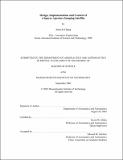| dc.contributor.advisor | David W. Miller. | en_US |
| dc.contributor.author | Chung, Soon-Jo, 1976- | en_US |
| dc.contributor.other | Massachusetts Institute of Technology. Dept. of Aeronautics and Astronautics. | en_US |
| dc.date.accessioned | 2007-10-22T16:32:20Z | |
| dc.date.available | 2007-10-22T16:32:20Z | |
| dc.date.copyright | 2002 | en_US |
| dc.date.issued | 2002 | en_US |
| dc.identifier.uri | http://hdl.handle.net/1721.1/39262 | |
| dc.description | Thesis (S.M.)--Massachusetts Institute of Technology, Dept. of Aeronautics and Astronautics, 2002. | en_US |
| dc.description | This electronic version was submitted by the student author. The certified thesis is available in the Institute Archives and Special Collections. | en_US |
| dc.description | Includes bibliographical references (p. 213-217). | en_US |
| dc.description.abstract | The quest for higher angular resolution in astronomy will inevitably lead to larger and larger apertures. Unfortunately, the diameter size of primary mirrors for space telescopes is limited by the volume and mass constraints of current launch vehicles as well as the scaling laws of manufacturing costs. Efforts are ongoing to break this trend by employing exotic technologies such as deployed segmented mirror telescopes, and sparse aperture optics using interferometry. In order to better understand the technological difficulties involved in designing and building a sparse aperture array, the challenge of building a white light Golay-3 telescope was undertaken. The MIT Adaptive Reconnaissance Golay- 3 Optical Satellite (ARGOS) project exploits wide-angle Fizeau interferometer technology with an emphasis on modularity in the optics and spacecraft subsystems. Unique design procedures encompassing the nature of coherent wavefront sensing, control and combining as well as various systems engineering aspects to achieve cost effectiveness, are developed. To demonstrate a complete spacecraft in a 1-g environment, the ARGOS system is mounted on a frictionless air-bearing, and has the ability to track fast orbiting satellites like the ISS or the planets. Wavefront sensing techniques are explored to mitigate initial misalignment and to feed back real-time aberrations into the optical control loop. This paper presents the results and the lessons learned from the conceive, design and implementation phases of ARGOS. A preliminary assessment shows that the beam combining problem is the most challenging aspect of sparse optical arrays. The need for optical control is paramount due to tight beam combining tolerances. The wavefront sensing/control requirements appear to be a major technology and cost driver. | en_US |
| dc.description.statementofresponsibility | by Soon-Jo Chung. | en_US |
| dc.format.extent | 238 p. | en_US |
| dc.language.iso | eng | en_US |
| dc.publisher | Massachusetts Institute of Technology | en_US |
| dc.rights | M.I.T. theses are protected by copyright. They may be viewed from this source for any purpose, but reproduction or distribution in any format is prohibited without written permission. See provided URL for inquiries about permission. | en_US |
| dc.rights.uri | http://dspace.mit.edu/handle/1721.1/7582 | |
| dc.subject | Aeronautics and Astronautics. | en_US |
| dc.title | Design, implementation and control of a sparse aperture imaging satellite | en_US |
| dc.title.alternative | Sparse aperture imaging satellite | en_US |
| dc.type | Thesis | en_US |
| dc.description.degree | S.M. | en_US |
| dc.contributor.department | Massachusetts Institute of Technology. Department of Aeronautics and Astronautics | |
| dc.identifier.oclc | 54069126 | en_US |
